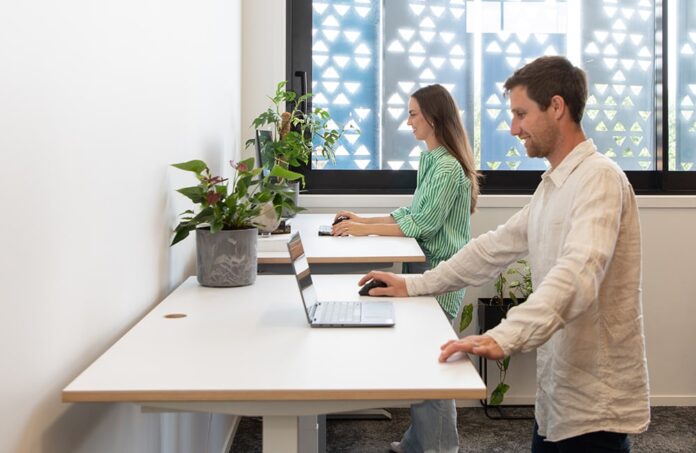
Are you tired of feeling stiff and sore after a long day at work? Are you looking for ways to improve your posture and reduce back pain? Look no further than the standing desk! They have become increasingly popular in recent years as people discover the many benefits of working on their feet.
Improving Posture

One major advantage of standing desks lies in their capacity to improve your posture. The correct use of these tables encourages better alignment of your body, fostering an upright posture. This is especially important given the surge of remote work and extended screen time, which often results in a hunched or slouched posture, also known as the notorious ‘tech neck.’
They discourage this slouching behavior by maintaining your screen at eye level, ensuring your head, neck, and spine stay in their natural alignment. This correct positioning reduces strain on your cervical vertebrae, mitigates the chances of developing chronic musculoskeletal disorders, and contributes to a more confident appearance. However, it’s essential to use a standing desk correctly, adjusting the height and screen distance to suit your specific needs.
The key to improving your posture lies in balance. Standing all day can be just as harmful as sitting continuously. The ideal strategy is to alternate between standing and sitting. This promotes muscle engagement and relaxation in turn, reducing fatigue, and enhancing overall postural health. This balance helps cultivate what’s known as ‘dynamic posture’ – the ability to maintain good posture regardless of whether you’re standing, sitting, or moving around.
Reducing Back Pain
Back pain is an all-too-common complaint among today’s workforce, often attributed to prolonged sitting. This is where standing desks truly shine—they can significantly help in reducing and potentially eliminating work-related back pain. The reason lies in the unique demands that standing places on our musculoskeletal system, which differ vastly from those of sitting.
When you sit, your lower back supports most of your upper body weight, causing the lumbar discs to compress. Over time, this leads to stiffness and pain. In contrast, standing encourages a more even distribution of body weight, alleviating pressure on your lumbar spine. Furthermore, it engages your core muscles, strengthening them over time, which indirectly supports your back and reduces pain.
However, reducing back pain isn’t as simple as switching from sitting to standing. It involves the correct use of these desks, coupled with regular movement and stretches. These practices ensure that your muscles don’t become overstrained, which can lead to a different set of complications. Ultimately, the key to reducing back pain lies in balance, awareness, and correct usage of your standing desk.
Ergonomics and Design Considerations

When choosing a desk, ergonomics should be your guiding principle. Ergonomics refers to the science of designing and arranging things people use so that the people and things interact most efficiently and safely. A good standing desk should have adjustable features to fit your body dimensions and work style, fostering comfort, efficiency, and injury prevention.
The height of your desk is the first crucial aspect to consider. It should align with your elbow height when your arms are at a 90-degree angle, and your wrists should be straight when typing. The screen should be at or slightly below eye level to prevent neck strain. Look for desks with easy-to-use adjustment mechanisms to switch between sitting and standing modes seamlessly.
A standing desk alone, though, isn’t a cure-all. Its efficacy is significantly amplified when complemented with other ergonomic equipment, such as adjustable chairs, footrests, anti-fatigue mats, and monitor arms. These accessories can optimize your workspace to your unique needs, maximizing the benefits you reap from your standing desk.
Incorporating Movement and Active Work
While standing desks offer numerous benefits, it’s important not to overlook the value of movement in maintaining our health. Standing still for prolonged periods can cause discomfort and potentially lead to conditions like varicose veins. That’s where the concept of ‘active work’ comes into play, involving regular movements and changes in posture during the workday.
One way to incorporate movement into your work routine is by adopting a sit-stand cycle. Experts suggest a ratio of 2:1 for sitting and standing. For every 30 minutes, stand for 20 minutes and sit for 10. This practice helps balance the load on your body, preventing overexertion while still reaping the benefits of standing.
Consider integrating light exercises into your workday. Simple stretches, marching on the spot, or even a short walk can mitigate the potential drawbacks of standing and keep your body dynamic. Movement is key in maintaining flexibility, promoting blood circulation, and keeping your muscles engaged and healthy.
Tips for Properly Using a Standing Desk

Start by positioning your screen correctly: it should be about an arm’s length away, and the top of the screen should be at or slightly below eye level. This reduces the strain on your neck and eyes. Your keyboard and mouse should be placed so that your wrists are straight, and your elbows are close to your body at a 90-degree angle.
Stand with your feet hip-width apart, and wear supportive footwear. This stance ensures you maintain balance and don’t strain your feet. An anti-fatigue mat can also be beneficial as it encourages subtle movements and relieves pressure on your feet and legs. Regular breaks are crucial. Just as prolonged sitting can be harmful, so can extended standing. Make sure to alternate between the two and move around regularly.
Maintain a neutral posture – your head, neck, spine, and hips should be aligned, and your back should be straight. Avoid leaning on the desk or standing on one leg, as these can lead to discomfort and imbalances. As with any new routine, start slowly and gradually increase your standing time as your body adapts.
Conclusion
Standing desks are an effective and cost-effective way to improve posture, reduce back pain, maintain healthy body weight, and optimize productivity. They can also be customized to fit your individual needs by adjusting the height of the desk and adding ergonomic accessories. With all these benefits in mind, they offer a great solution for those who want to increase their work efficiency while improving their overall health. So if you’re ready to take charge of your well-being at work, it may be worth investing in a standing desk today!





